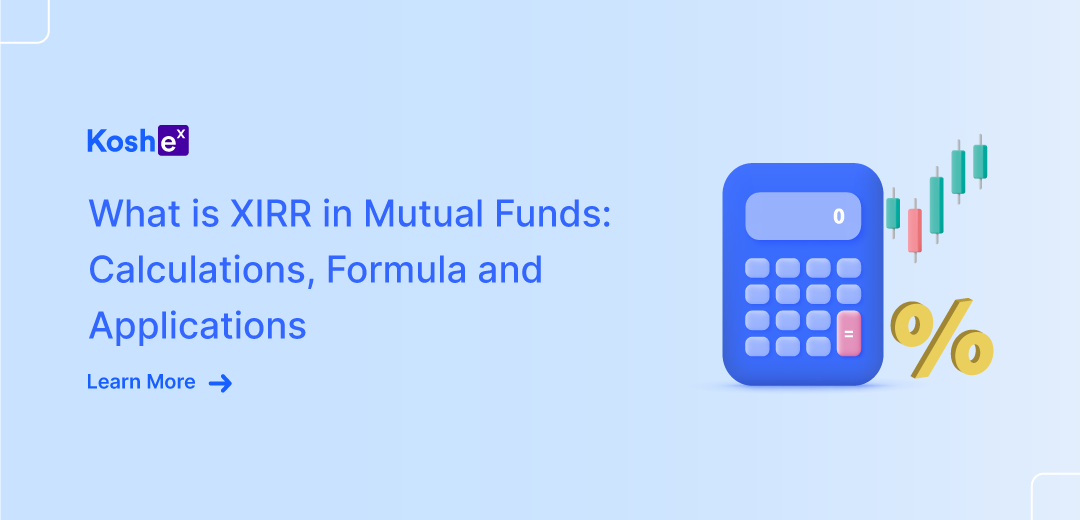When it comes to investing in mutual funds, many investors face the challenge of accurately calculating returns, especially when investments are made at different times. While the Compound Annual Growth Rate (CAGR) is commonly used to calculate returns, it falls short in handling multiple cash flows that occur in irregular intervals. So, XIRR is used to solve this problem specifically.
In this blog, we will be taking a detailed look at what XIRR is, how it works, how to calculate it, and its practical applications in mutual funds.
What Is XIRR?
XIRR (Extended Internal Rate of Return) is a financial metric used to calculate the annualised return on investments, particularly when cash flows (investments and withdrawals) happen at varying intervals. Thus this calculation is generally used to calculate returns of SIP (Systematic Investment Plan).
For example, you start an SIP for 12 months, skip 2 months, and then resume investing. On top of that, you also keep changing the investment amount at regular intervals. Hence, in these scenarios, XIRR will be used to calculate the returns of multiple transactions that were executed at different times.
Also Read: What Is Compounding?
What Are The Differences Between CAGR and XIRR?
You may wonder why we need XIRR when we can use CAGR to calculate the growth of our investment over time. In the below table, we will explain the difference between CAGR and XIRR so that you can understand the importance of both metrics.
| Feature | XIRR | CAGR |
Description | It shows the annual growth of mutual fund investments over some time. | It shows the average rate earned by every cash flow that you invest during a period. |
Best suited for | Investments with multiple deposits/withdrawals (SIPs, dividends). | Lump sum investments with no additional deposits/withdrawals. |
| Calculation | Considers timing and amount of each cash flow. | Uses only starting and ending investment values. |
| Cash Flows | Considers multiple cash flows. | Doesn’t consider multiple cash flows. |
| Return | Measures Absolute Return. | Measures Only Annualised Return. |
| Use | Useful for measuring the return from lump sum investments in mutual funds. | Useful for measuring mutual fund returns through SIP and SWP (Systematic Withdrawal Plan). |
| Accuracy for SIPs | More accurate, as it reflects the reinvestment of returns. | Less accurate, and may underestimate returns. |
How To Calculate XIRR?
The formula to calculate XIRR is:
XIRR = (NPV (Cash Flows, r) / Initial Investment) * 100
Where
NPV is Net Asset Value
r is the rate of return
Cash Flows are a series of investments and withdrawals over time.
Let’s say, you invest ₹10,000 in a mutual fund scheme every month. XIRR considers it whenever the investment of an amount is made. The reason behind this is that the money put in earlier worked harder for you than the recent contributions. Therefore, a simple average return is not sufficient. An XIRR overcomes this by calculating an annualised return considering these differences in time.
Suppose you invest ₹10,000 every month for one year and your total grows to ₹1.2 lakhs. XIRR will consider the ₹10,000 invested in January and will work for 12 months, whereas the contribution in December will work for 1 month only. Thus it will give you a better idea of how your investment returned during the one year.
Also Read: Absolute Return vs CAGR: How to Measure Mutual Fund Performance
How To Calculate XIRR In Excel?
You can calculate XIRR using Microsoft Excel or any similar application, as it is tedious to calculate XIRR using pen and paper. All you need to know is your SIP amount, SIP amounts, maturity amount, and maturity date.
Here is a step-by-step guide on how to calculate XIRR in Excel:
- Open a blank workbook on MS Excel.
- In one column, write the header ‘Transaction Date’ and start entering the transaction date right below it.
- In the next column, write the header ‘Cash Flow’ and start adding the SIP amount against the respective dates.
- In the first column, write the date of redemption at the bottom i.e. in the cell just below the last transaction date.
- In any cell, type ‘=‘. This will invoke the formula function. Following this, type XIRR. Select the formula that appears by either pressing Tab on the keyboard or left-click on the mouse. When the formula asks you to enter values, select all values in the Cash Flow column from top to bottom. Now, type a comma and select all dates.
- Close the bracket and press Enter, keep the cell you entered when the formula is selected and click on the per cent (%) button in the Number section under the Home ribbon. This will convert the result into a percentage. This is the XIRR you are looking for. In our example, the fund returned 14.87% in the indicated period.
What Are The Practical Applications Of XIRR In Mutual Funds?
Systematic Investment Plans (SIP)
One of the most common applications of XIRR is in calculating returns from an SIP. In an SIP, investors
contribute a fixed amount at regular intervals, but the value of those contributions can differ based on market performance. Calculating XIRR allows investors to understand the real growth of their investments, accounting for each SIP instalment.
For example, if an investor makes monthly SIPs of ₹5,000 for three years, XIRR will help calculate the overall return by factoring in the fluctuating NAV and timing of each contribution.
Multiple Investments and Redemptions
XIRR is equally useful when you have multiple lump-sum investments or withdrawals. For example, if you invest ₹50,000 in a mutual fund today and add ₹25,000 a few months later, then redeem ₹30,000 after a year, XIRR will calculate the effective return on your total portfolio, accounting for the different dates of each transaction.
Different Investment Strategies
Investors often use XIRR to compare different strategies, like comparing SIP returns with lump-sum investments’ returns. By calculating the XIRR for both strategies, you can understand which one gave better returns for a given period. This is particularly useful when investors are deciding how they should be allocating their future investments.
Tax Implications
XIRR can offer insight into the tax implications of mutual fund investments. Different types of mutual funds (equity vs. debt) have different holding periods for short-term and long-term capital gains. When investors understand the XIRR of their investment, it becomes easy for them to help decide when to redeem units for maximum tax efficiency.
Portfolio Monitoring and Rebalancing
Calculating XIRR can help assess the performance of the investment portfolio in real terms. This can help investors make informed decisions on whether to hold or sell certain mutual funds and rebalance their portfolios accordingly.
What Are The Limitations Of XIRR?
Even though XIRR is a highly useful tool, below are its limitations.
Needs accurate data – XIRR is only as accurate as the data you provide. Incorrect dates or cash flows will affect the results.
Only works for realised gains – XIRR works best when one has a clear start and end point (i.e. redemption). For ongoing investments, it can offer an estimated return but the actual return may be different when the investments are realised.
Assumes reinvestment at XIRR – XIRR assumes that all future cash flows will earn the same rate of return. However, this may not hold true in a volatile market.
XIRR In Mutual Funds – The Conclusion
XIRR is an important metric for mutual fund investors, especially those who invest through SIPs or make staggered investments. It offers a more accurate and realistic view of returns compared to simple metrics such as the CAGR. Be it tracking the performance of your current investments, comparing strategies, or planning tax-efficient withdrawals, XIRR is the best tool for understanding the true rate of return on your
mutual fund portfolio.
When you use the XIRR, you will be able to make more informed investment decisions, better manage your portfolio, and maximise your returns over time. So, the next time you review your mutual fund performance, make sure to use XIRR to get a comprehensive and accurate picture of your investments.
If you wish to invest in Mutual Funds and Digital Gold or track your EMIs, and PF, you can download the Koshex app for free today. Manage and grow your money like a professional with our app. Sign up now!
Frequently Asked Questions (FAQs)
Can XIRR be negative?
Yes. XIRR can be negative if your investments have resulted in a loss over the period.
Can I calculate XIRR for ongoing investments?
Yes. You can calculate XIRR for ongoing investments, but the result will reflect the performance up to the latest transaction date. The XIRR may change once you redeem your investments or make future investments.
How does XIRR handle partial withdrawals or redemptions?
Each withdrawal is treated as a separate cash flow in the XIRR calculation, ensuring that your financial return reflects the actual series of transactions over the investment period.









Leave a Comment